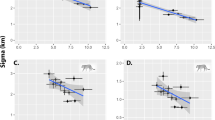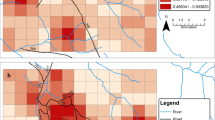Abstract
Context
The Amur tiger and leopard, once roaming over the Eurasian continent, are now endangered and confined to the Sikhote-Alin Mountains, Russia—a landscape that has been increasingly fragmented due to human activities. The ultimate fate of these big cats depends on whether they can resettle in their previous main historical range in NE China. Recent sightings of these animals along the China–Russia border have aroused new hope, but direct evidence is lacking.
Objectives
The main objectives of our study were (1) to determine the abundance and spatiotemporal patterns of tigers, leopards, and primary prey; (2) to investigate factors influencing the resettlement of the two big cats; and (3) to propose a landscape-scale conservation plan to secure the long-term sustainability of the Amur tiger and leopard.
Methods
We monitored the two felids, their prey, and human activities, with 380 camera-trap stations, for a total of 175,127 trap days and over an area of 6000 km2 in NE China. We used the constraint line method to characterize cattle grazing and human influences on tigers, leopards, and their prey species.
Results
Our results show that, unexpectedly, at least 26 tigers and 42 leopards are present within China, which are confined primarily to a narrow area along the border with Russia. We have further identified that cattle grazing and human disturbances are the key hurdles to the dispersal of the tigers and leopards farther into China where suitable habitat is potentially available.
Conclusions
Amur tigers and leopards are returning to China, indeed, but their long-term resettlement is not likely without active and timely conservation efforts on landscape and regional scales. To overcome the hurdles to the resettlement of tigers and leopards in China, we propose a “Tiger and Leopard Resettlement Program” that will engage the government, local communities, and researchers, so that the long-term sustainability of the Amur tigers and leopards can be ensured.









Similar content being viewed by others
References
Ahearn SC, Smith JLD, Joshi AR, Ding J (2001) TIGMOD: an individual-based spatially explicit model for simulating tiger/human interaction in multiple use forests. Ecol Model 140(1–2):81–97
Barlow ACD, McDougal C, Smith JLD, Gurung B, Bhatta SR, Kumal S, Mahato B, Tamang DB (2009) Temporal variation in tiger (Panthera tigris) populations and its implications for monitoring. J Mammal 90(2):472–478
Carroll C, Miquelle DG (2006) Spatial viability analysis of Amur tiger Panthera tigris altaica in the Russian Far East: the role of protected areas and landscape matrix in population persistence. J Appl Ecol 43(6):1056–1068
Dave C, Jhala Y (2011) Is competition with livestock detrimental for native wild ungulates? A case study of chital (Axis axis) in Gir Forest, India. J Trop Ecol 27:239–247
Feng LM, Wang TM, Mou P, Kou XJ, Ge JP (2011) First image of an Amur leopard recorded in China. Cat News 55(Autumn):9
Gilbert M, Miquelle DG, Goodrich JM, Reeve R, Cleaveland S, Matthews L, Joly DO (2014) Estimating the potential impact of canine distemper virus on the Amur tiger population (Panthera tigris altaica) in Russia. PLoS One 9(10):e110811
Goodrich JM, Miquelle DG, Smirnov EN, Kerley LL, Quigley HB, Hornocker MG (2010) Spatial structure of Amur (Siberian) tigers (Panthera tigris altaica) on Sikhote-Alin Biosphere Zapovednik, Russia. J Mammal 91(3):737–748
Guo Q, Brown JH, Enquist BJ (1998) Using constraint lines to characterize plant performance. Oikos 83(2):237–245
Gurung B, Smith JLD, McDougal C, Karki JB, Barlow A (2008) Factors associated with human-killing tigers in Chitwan National Park, Nepal. Biol Conserv 141(12):3069–3078
Hayward MW, Jedrzejewski W, Jedrzewska B (2012) Prey preferences of the tiger Panthera tigris. J Zool 286(3):221–231
Hebblewhite M, Miguelle DG, Murzin AA, Aramilev VV, Pikunov DG (2011) Predicting potential habitat and population size for reintroduction of the Far Eastern leopards in the Russian Far East. Biol Conserv 144(10):2403–2413
Hebblewhite M, Zimmermann F, Li Z, Miquelle DG, Zhang M, Sun H, Mörschel F, Wu Z, Sheng L, Purekhovsky A, Chunquan Z (2012) Is there a future for Amur tigers in a restored tiger conservation landscape in Northeast China? Anim Conserv 15(6):579–592
Hebblewhite M, Miquelle DG, Robinson H, Pikunov DG, Dunishenko YM, Aramilev VV, Nikolaev IG, Salkina GP, Seryodkin IV, Gaponov VV, Litvinov MN, Kostyria AV, Fomenko PV, Murzin AA et al (2014) Including biotic interactions with ungulate prey and humans improves habitat conservation modeling for endangered Amur tigers in the Russian Far East. Biol Conserv 178:50–64
Henry P, Miquelle D, Sugimoto T, McCullough DR, Caccone A, Russello MA (2009) In situ population structure and ex situ representation of the endangered Amur tiger. Mol Ecol 18(15):3173–3184
Horning M (2012) Constraint lines and performance envelopes in behavioral physiology: the case of the aerobic dive limit. Front Physiol 3:1–9
Jiang GS, Sun HY, Lang JM, Yang LJ, Li C, Lyet A, Long B, Miquelle DG, Zhang CZ, Aramilev S, Ma JZ, Zhang MH (2014) Effects of environmental and anthropogenic drivers on Amur tiger distribution in northeastern China. Ecol Res 29(5):801–813
Jilin Statistical Bureau (2013) Jilin statistical yearbook (in Chinese). China Statistics Press, Beijing
Johnson A, Vongkhamheng C, Hedemark M, Saithongdam T (2006) Effects of human-carnivore conflict on tiger (Panthera tigris) and prey populations in Lao PDR. Anim Conserv 9(4):421–430
Jutzeler E, Wu ZG, Liu WS, Breitenmoser U (2010) Leopard. Cat News 5(Autumn):30–33
Kenney J, Allendorf FW, McDougal C, Smith JLD (2014) How much gene flow is needed to avoid inbreeding depression in wild tiger populations? P R Soc B 281(1789):20133337
Kerley LL, Mukhacheva AS, Matyukhina DS, Salmanova E, Salkina GP, Miquelle DG (2015) A comparison of food habits and prey preference of Amur tiger (Panthera tigris altaica) at three sites in the Russian Far East. Integr Zool 10(4):354–364
Li ZW, Wu JG, Kou XJ, Tian Y, Wang TM, Mu P, Ge JP (2009) Land use pattern and its dynamics changes in Amur tiger distribution region. Chin J Appl Ecol 20(3):713–724 (in Chinese)
Madhusudan MD (2004) Recovery of wild large herbivores following livestock decline in a tropical Indian wildlife reserve. J Appl Ecol 41(5):858–869
Miquelle DG, Smirnov EN, Quigley HB, Hornocker MG (1996) Food habits of Amur tigers in the Sikhote-Alin Zapovednik and the Russian Far East, and implications for conservation. J Wildl Res 1:138–147
Miquelle DG, Pikunov DG, Dunishenko YM, Aramilev VV, Nikolaev IG, Smirnov EN, Salkina GP, Seryodkin IV, Gapanov VV, Fomenko PV, Litvinov MN, Kostyria AV, Korkisko VG, Murzin AA (2006) A survey of Amur (Siberian) tigers in the Russian Far East, 2004–2005. Final Report to the Save the Tiger Fund. Wildlife Conservation Society, New York, p. 77
Miquelle DG, Goodrich JM, Kerley LL, Pikunov DG, Dunishenko YM, Aramiliev VV, Nikolaev IG, Smirnov EN, Salkina GP, Endi Z, Seryodkin IV, Carroll C, Gapanov VV, Fomenko PV, Kostyria AV, Murzin AA, Quigley HB, Hornocker MG (2010a) Science-based conservation of Amur tigers in the Russian Far East and Northeast China. In: Tilson R, Nyhus PJ (eds) Tiger of the world. The science, politics, and conservation of Panthera tigris, 2nd edn. Elsevier Limited, Oxford, pp 403–423
Miquelle DG, Goodrich JM, Smirnov EN, Stephens PA, Zaumyslova OY, Chapron G, Kerley L, Murzin AA, Hornocker MG, Quigley HB (2010b) The Amur tiger: a case study of living on the edge. In: Macdonald DW, Loveridge AJ (eds) Biology and conservation of wild felids. Oxford University Press, Oxford, pp 325–339
O’Brien TG, Kinnaird MF, Wibisono HT (2003) Crouching tigers, hidden prey: Sumatran tiger and prey populations in a tropical forest landscape. Anim Conserv 6:131–139
Pikunov DG, Miquelle DG, Abramov VK, Nikolaev IG, Seredkin IV, Murzin AA, Korkishko VG (2003) A survey of Far Eastern leopard and Amur tiger populations in Southwest Primorski Krai, Russian Far East (February 2003). Pacific Institute of Geography (FEB RAS), Wildlife Conservation Society, and Tigris Foundation, Vladivostok
Pikunov DG, Seredkin IV, Aramilev VV, Nikolaev IG, Murzin AA (2009) Numbers of Far Eastern Leopards (Panthera pardus orientalis) and Amur Tigers (Panthera tigris altaica) in Southwest Primorski Krai, Russian Far East, 2007. Dalnauka, Vladivostok
Ridout MS, Linkie M (2009) Estimating overlap of daily activity patterns from camera trap data. J Agric Biol Environ Stat 14(3):322–337
Simcharoen A, Savini T, Gale GA, Simcharoen S, Duangchantrasiri S, Pakpien S, Smith JLD (2014) Female tiger Panthera tigris home range size and prey abundance: important metrics for management. Oryx 48(3):370–377
Smith JLD, McDougal CW, Sunquist ME (1987) Female land tenure system in tigers. In: Tilson RL, Seal US (eds) Tigers of the world: the biology, biopolitics, management and conservation of an endangered species. Noyes Publications, Park Ridge, pp 97–108
Soh YH, Carrasco LR, Miquelle DG, Jiang J, Yang J, Stokes EJ, Tang J, Kang A, Liu P, Rao M (2014) Spatial correlates of livestock depredation by Amur tigers in Hunchun, China: relevance of prey density and implications for protected area management. Biol Conserv 169:117–127
Stewart KM, Bowyer RT, Kie JG, Cimon NJ, Johnson BK (2002) Temporospatial distributions of elk, mule deer, and cattle: resource partitioning and competitive displacement. J Mammal 83(1):229–244
Sugimoto T, Nagata J, Aramilev VV, McCullough DR (2012) Population size estimation of Amur tigers in Russian Far East using noninvasive genetic samples. J Mammal 93(1):93–101
Sugimoto T, Aramilev VV, Kerley LL, Nagata J, Miquelle DG, McCullough DR (2014) Noninvasive genetic analyses for estimating population size and genetic diversity of the remaining Far Eastern leopard (Panthera pardus orientalis) population. Conserv Genet 15(3):521–532
Thomson JD, Weiblen G, Thomson BA, Alfaro S, Legendre P (1996) Untangling multiple factors in spatial distributions: lilies, gophers, and rocks. Ecology 77(6):1698–1715
Tian Y, Wu JG, Kou XJ, Li ZW, Wang TM, Mou P, Ge JP (2009) Spatiotemporal pattern and major causes of the Amur tiger population dynamics. Biol Sci 17(3):211–225 (in Chinese)
Tian Y, Wu JG, Smith AT, Wang TM, Kou XJ, Ge JP (2011) Population viability of the Siberian tiger in a changing landscape: going, going and gone? Ecol Model 222(17):3166–3180
Tian Y, Wu JG, Wang TM, Ge JP (2014) Climate change and landscape fragmentation jeopardize the population viability of the Siberian tiger (Panthera tigris altaica). Landscape Ecol 29(4):621–637
Uphyrkina O, Miquelle D, Quigley H, Driscoll C, O’Brien SJ (2002) Conservation genetics of the Far Eastern leopard (Panthera pardus orientalis). J Hered 93(5):303–311
Wang TM, Yang HT, Xiao WH, Feng LM, Mou P, Ge JP (2014) Camera traps reveal Amur tiger breeding in NE China. Cat News 61(Autumn):18–19
Wei YW, Yu DP, Lewis BJ, Zhou L, Zhou W, Fang X, Zhao W, Wu S, Dai L (2014) Forest carbon storage and tree carbon pool dynamics under natural forest protection program in northeastern China. Chin Geogr Sci 24(4):397–405
Xiao WH, Feng LM, Zhao XD, Yang HT, Dou HL, Cheng YC, Mou P, Wang TM, Ge JP (2014) Distribution and abundance of Amur tiger, Amur leopard and their ungulate preys in Hunchun National Nature Reserve, Jilin. Biodiver Sci 22(6):717–724 (in Chinese)
Young TP, Palmer TM, Gadd ME (2005) Competition and compensation among cattle, zebras, and elephants in a semi-arid savanna in Laikipia, Kenya. Biol Conserv 122(2):351–359
Zhou SC, Sun HY, Zhang MH, Lu XD, Yang J, Li L (2008) Regional distribution and population size fluctuation fo wild Amur tiger (Panthera tigris altaica) in Heilongjiang Province. Acta Theriol Sin 28(2):165–173 (in Chinese)
Acknowledgments
We sincerely thank Somphot Duangchantrasiri and Saksit Simcharoen for their great help with verifying the identities of tiger and leopard individuals. We also thank the State Forestry Administration, Jilin Province Forestry Bureau, and the Forestry Industry Bureau of Heilongjiang Province for field assistance. This work was supported by grants from the National Natural Science Foundation of China (31210103911, 31270567, 31421063, 31200410, 31470566 and 31300458) and the National Scientific and Technical Foundation Project of China (2012FY112000).
Author information
Authors and Affiliations
Corresponding author
Additional information
Tianming Wang and Limin Feng contributed equally to this work.
Rights and permissions
About this article
Cite this article
Wang, T., Feng, L., Mou, P. et al. Amur tigers and leopards returning to China: direct evidence and a landscape conservation plan. Landscape Ecol 31, 491–503 (2016). https://doi.org/10.1007/s10980-015-0278-1
Received:
Accepted:
Published:
Issue Date:
DOI: https://doi.org/10.1007/s10980-015-0278-1




